How Casting a Line Can Reel in Better Hand-Eye Coordination
- Flying Fishman

- May 25
- 4 min read
Fishing is often seen as a peaceful hobby that brings you closer to nature. But did you know that it can also improve your hand-eye coordination? This article explores how fishing engages both your mind and body, making it a fun and effective way to sharpen your skills.
Understanding Hand-Eye Coordination
Hand-eye coordination is the ability to process visual information and guide hand movements effectively. Good coordination is essential for everyday tasks like typing, playing sports, cooking, and even driving. When you have strong hand-eye coordination, you can quickly turn what you see into action. Fishing is one of the underrated activities that can significantly boost this skill.
Studies have shown that hand-eye coordination can improve over time with practice and engagement in specific activities. For instance, research indicates that individuals who participate in activities requiring coordination can see improvements of up to 30% in a few weeks of consistent practice.
The Mechanics of Casting
Casting a fishing line involves several actions that require excellent hand-eye coordination. Here’s how it works:
Assessing Distance and Wind: When you cast, you need to judge how far you want your lure to go while accounting for wind direction. This requires mental calculations and visual judgment.
Timing and Release: Timing your release while casting is crucial. If you release too early or too late, your line may not reach your target.
Each fishing rod and reel has its unique features, which adds complexity to the task. Learning how to use them while focusing on your target helps develop your overall coordination over time.
The Role of Focus and Concentration
Fishing is not just about throwing a line into the water; it’s a test of patience and concentration. While fishing, you need to stay alert, watching for signs of fish activity. Filtering out distractions and honing your focus improves how your brain processes visual information.
For example, studies show that spending time in nature can enhance mental clarity by up to 50%. This mental clarity translates into better reactions and coordination, making fishing a valuable practice for anyone looking to improve their skills.
Practicing the Reeling Technique
Once you’ve successfully cast your line, the next step is reeling in your catch. This phase is where hand-eye coordination shines. You need to monitor the line and bobber or lure and adjust your rod's angle and tension.
When a fish bites, quick reactions are vital. You must reel in the fish smoothly, balancing the tension on the line to avoid breaking it. This synchronization between hand movements and visual cues offers a great workout for your hand-eye coordination.

Engaging Both Sides of the Brain
Fishing engages both the left and right sides of your brain. The left side handles logic and analytical thinking, while the right side deals with creativity and spatial awareness. Learning new fishing techniques activates both areas, enhancing your cognitive abilities.
For instance, mastering different casting techniques or adapting to changing water conditions requires both strategic thinking and physical skill, leading to improved coordination.
Outdoor Environment and Its Impact
Fishing takes place in a natural setting, which brings numerous benefits. Being outdoors can boost your mood and lower stress levels. A clear mind helps with better decision-making and faster reactions.
Research shows that exposure to nature can reduce anxiety levels by 30% and enhance concentration. When you’re fishing, you’ll need to be aware of your surroundings, such as currents, weather changes, and other environmental factors. Adapting to these elements builds your coordination and agility.
Fishing Games: A Fun Way to Enhance Skills
If you want to practice hand-eye coordination in a fun way, consider fishing games. These range from virtual reality simulators to mobile apps that mimic casting and catching fish.
While these games can't replace real fishing, they can provide a safe environment to enhance your skills. Many offer realistic physics and challenges that can translate well to actual fishing experiences.
Participating in Different Fishing Styles
Fishing comes in many styles, and each emphasizes unique aspects of hand-eye coordination. Here are some techniques to consider:
Fly Fishing: This technique requires a different casting method, focusing on rhythm and timing, which enhances your fine motor skills.
Bait Casting: This style emphasizes precision, helping you judge distances and angles effectively, further honing your spatial awareness.
Ice Fishing: While it involves less movement, ice fishing improves your ability to focus while managing more than one line.
Experimenting with different fishing styles keeps the experience enjoyable and continuously trains your coordination.
Family and Social Benefits
Fishing is often a group activity, providing excellent bonding opportunities with family and friends. Engaging in fishing together builds teamwork, communication, and patience.
Sharing the experience can make learning new techniques easier and less frustrating. This social interaction not only enhances your enjoyment but also contributes to improving hand-eye coordination as you learn from one another.
Setting Goals in Fishing
Setting personal goals can motivate you to improve your fishing skills. Whether you aim to catch a specific species or master a new casting technique, goal-setting can provide direction.
Focusing on a specific target gives your practice purpose and hones your hand-eye coordination. The feeling of achieving personal milestones boosts your love for fishing and enhances your skills along the way.
Final Thoughts
Fishing is more than a leisurely pastime; it’s an effective way to improve your hand-eye coordination while enjoying the outdoors. Whether you’re casting, reeling, or simply soaking in the environment, every aspect of fishing sharpens both your mind and body.
Next time you find yourself by the water, take a moment to appreciate how this simple activity benefits your physical and mental agility. Grab your fishing rod and experience the joy of improving your hand-eye coordination through fishing.



